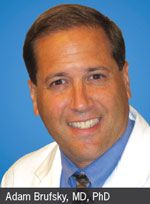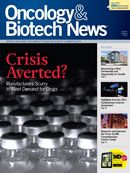Publication
Article
Oncology & Biotech News
Brufsky Urges Caution in Translating Assays
Author(s):
Amid advances in gene-based cancer diagnostics, questions about the best use of molecular and cellular assays in practice are growing along with the new options for clinicians.

Amid advances in gene-based cancer diagnostics, questions about the best use of molecular and cellular assays in practice are growing along with the new options for clinicians.
Adam Brufsky, MD, PhD, professor of medicine, associate chief of hematology-oncology, and co-director of the Comprehensive Breast Center at the University of Pittsburgh School of Medicine, in Pennsylvania, urged caution in translating promising assay diagnostics into treatment decisions. The diversity of breast cancer cells makes analyzing specimens a complex matter, Brufsky indicated. “Intertumor heterogeneity makes us take a step back from these sort of assays. I think we have to be very, very careful as we go forward,” he said.
Brufsky provided these insights from his review of the latest research:
- PAM50—This gene expression assay, which classifies breast cancers into 5 subtypes and evaluates risk of recurrence, may be able to predict which patients need adjuvant chemotherapy. “Genomic analysis may help us figure out a subset of patients for neoadjuvant hormonal therapy,” Brufsky said. “That’s all they would need is neoadjuvant hormonal therapy alone.”
- RSPC—The risk assessment index, which combines the score from the 21-gene evaluation recurrence score (RS) with pathologic and clinical (RSPC) information, is complicated to use in clinical practice and does not aid significantly in making decisions about whether or not to recommend chemotherapy, Brufsky said. He suggested staying with the RS score to analyze nodes for estrogen receptor-positive factors.
- CYP2D6—The genotyping test did not predict the benefit of tamoxifen in 2 large prospective clinical trials, Brufsky noted. “Genotying by CYP2D6 probably at this point in time is not very helpful,” he said. “What these data mean, I don’t think we’re sure of yet.”
- CTCs—The presence of circulating tumor cells (CTCs) in blood and disseminated tumor cells (DTCs) in bone marrow are “very interesting and important new technology,” Brufsky said. CTCs >5 per 7.5 mL of blood appear to predict treatment outcomes in metastatic breast cancer. Brufsky, however, said researchers are still digesting study data. “The studies have been all over the map,” he said. “I don’t know where the application is going to go.” “Using CTCs right now in clinical practice— I’m not sure it’s ready for prime time,” he added.






























%20(2)%201-Recovered-Recovered-Recovered-Recovered-Recovered-Recovered-Recovered-Recovered-Recovered-Recovered-Recovered-Recovered-Recovered-Recovered-Recovered-Recovered-Recovered.jpg?fit=crop&auto=format)
%20(2)%201-Recovered-Recovered-Recovered-Recovered-Recovered-Recovered-Recovered-Recovered-Recovered-Recovered-Recovered-Recovered-Recovered-Recovered-Recovered-Recovered-Recovered.jpg?fit=crop&auto=format)
